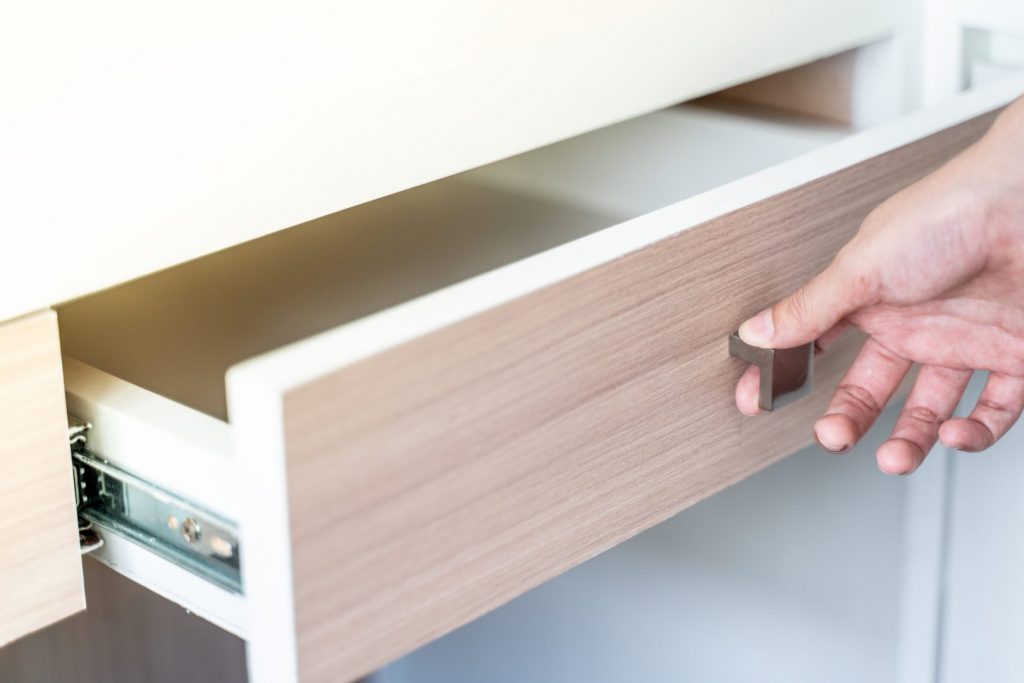
Opening a drawer with a small pull can be challenging visually and for grasping and leveraging it – a factor often overlooked in design that can be accommodated with a longer bar that can be grabbed
Aging in place as a strategy and universal design as a concept are closely related but very different at the same time. Their purposes are different. So how do we know which one we should advocate or focus on with our clients since both are popular design topics?
On the one hand, aging in place is a design strategy that focuses on making a dwelling – specific to the individual or individuals in that living space – safe, comfortable, accessible, and enjoyable so that they can live independently in that home for the rest of their lives (unless a serious medical issue forces relocation to a hospital, rehab center, or memory care facility).
The design treatments are personalized and individualized as necessary to address and accommodate the specific needs of the people in the household without as much regard for how people not living there would respond to seeing or using the treatments that are being created and implemented.
However, rather than remodel, rehabilitate, reconfigure, or update their current home to make it more to their liking or more appropriate for their current situation, some people choose to look elsewhere and find another living arrangement to move from the home they are occupying. They opt for a different floor plan that they believe can accommodate them long-term (one-level, easier entry and navigation, more storage, newer design, more technology features, smaller and more compact, or other advantageous features).
While technically this can be called aging in place because wherever someone is residing is where they are aging in place, it’s beyond the spirit of aging in place which is to modify or otherwise address issues in the current home so that moving from it is unnecessary and the occupants can maintain safe and viable lifestyles in their present homes for the rest of their days.
Universal design, on the other hand, is a type of design strategy or concept that attempts to make features in the home usable by and accessible to anyone living in the home (regardless of age, size, physical strength, mobility, sensory capacity, cognition, or other considerations) and even those coming into the home for whatever reason who don’t reside there. The treatments are more global or generic in nature rather than specific to any individual. In fact, should the design solutions necessarily eliminate anyone from using them due to their ability or stature, the design is not considered to be universal in nature.
Nevertheless, the one thing that can be said about both design strategies is that they are just for residential applications. We only age in place in our homes. Sometimes it may seem like this happens at the workplace or elsewhere, but aging in place is strictly a residential strategy.
However, there is not a universal or comprehensive aging in place strategy that can apply to all homes or considerations for the simple reason that everyone presents different needs, requirements, and abilities. We cannot know know what each person is going to need to be able use their home well, and budgets for modifying homes vary tremendously as well.
Universal design is a strategy that helps us bridge this gap. It also is residential in nature although the same concept and strategies can apply to the marketplace. Only here (in the marketplace), we change the name to accessible design. Same idea, different emphasis. One is helping people – residents and visitors – to use their home space well. The other means that public spaces – the office or workplace, public transit, shopping centers, stores, warehouses, parks, airports, and any other place outside the home that we visit or frequent has the capacity to accommodate a range of abilities and needs. It eliminates the challenges or limitations for entering or using any particular space.
The idea of universal design is that the home environment can be designed in such a way as to allow anyone to use that space effectively. When specific needs are present, we can often find a way of appealing to them in a more aesthetic, generic way that works for more people than just the person for whom the design is based or seems to blend into the home environment without calling specific attention to the design for its specific use.
Either strategy is fine for accommodating people who want to remain in their present homes, but we have a choice in helping them. We can design something very specific for their needs, or we can create a design solution that works for anyone coming into that space. We can create a look with the design that blends into the current environment and does not single out the solution as anything special.
When we aren’t sure what someone’s needs might be in the future, or we just want to address coming sensory or mobility changes that happen with aging, universal design is a great approach for helping this to happen. Aging in place design is addressing the specifics of the individual, and universal design is providing for anyone’s ability in general.
